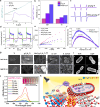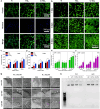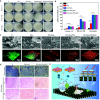Progress in visible-light-activated photocatalytic coatings to combat implant-related infections: From mechanistic to translational roadmap
- PMID: 40475082
- PMCID: PMC12137198
- DOI: 10.1016/j.bioactmat.2025.04.037
Progress in visible-light-activated photocatalytic coatings to combat implant-related infections: From mechanistic to translational roadmap
Abstract
Biomedical and dental implants have enhanced healthcare but concurrently increased the risk of infections. Innovations in smart biomaterials, especially those responding to light stimuli through photocatalytic mechanisms, are emerging as promising solutions for activating targeted antimicrobial responses. While extensive reviews have provided insight into photocatalysis and its medical and environmental applications, limited focus has been given to solutions specifically tailored for implant contexts. The recent introduction of photocatalysis in the implant field, particularly visible-light-triggered photocatalytic coatings, represents a versatile approach to managing infections. These coatings offer on-demand reactive oxygen species generation, delivering antibacterial effects against a range of pathogens. Hence, this comprehensive review aims to summarize the latest advancements in design principles, physicochemical modifications, and surface optimizations, along with novel research concepts towards the achievement of visible-light-triggered photocatalytic antibacterial activity. Moreover, through a systematic search, this review discusses the current state-of-the-art regarding the antimicrobial efficacy of these biomaterials and the key factors influencing their performance, including microorganism type, photocatalyst properties, light source and intensity, and exposure time. Finally, it provides an in-depth discussion of current challenges, future directions, and regulatory considerations targeting biofilm-related implant treatments, offering guidance for future clinical adoption of multifunctional photocatalytic coatings in implant therapy.
Keywords: Biofilms; Coatings; Implants; Light; Photocatalysis.
© 2025 The Authors.
Conflict of interest statement
The authors declare that they have no known competing financial interests or personal relationships that could have appeared to influence the work reported in this paper.
Figures




















Similar articles
-
Visible-Light-Induced Photocatalytic and Antibacterial Activity of TiO2 Codoped with Nitrogen and Bismuth: New Perspectives to Control Implant-Biofilm-Related Diseases.ACS Appl Mater Interfaces. 2019 May 22;11(20):18186-18202. doi: 10.1021/acsami.9b03311. Epub 2019 May 9. ACS Appl Mater Interfaces. 2019. PMID: 31038914
-
What challenges hinder the adoption of antimicrobial surface in the dental implant market?Expert Rev Med Devices. 2024 Dec;21(12):1081-1085. doi: 10.1080/17434440.2024.2440061. Epub 2024 Dec 11. Expert Rev Med Devices. 2024. PMID: 39648297 Review.
-
Recent Progress in antibacterial hydrogel coatings for targeting biofilm to prevent orthopedic implant-associated infections.Front Microbiol. 2023 Dec 22;14:1343202. doi: 10.3389/fmicb.2023.1343202. eCollection 2023. Front Microbiol. 2023. PMID: 38188584 Free PMC article. Review.
-
Thermal-Sprayed Photocatalytic Coatings for Biocidal Applications: A Review.J Therm Spray Technol. 2021;30(1-2):1-24. doi: 10.1007/s11666-020-01118-2. Epub 2020 Nov 4. J Therm Spray Technol. 2021. PMID: 38624582 Free PMC article. Review.
-
Advancing Light-Driven Reactions with Surface-Modified Optical Fibers.Acc Chem Res. 2025 May 20;58(10):1596-1606. doi: 10.1021/acs.accounts.5c00022. Epub 2025 May 1. Acc Chem Res. 2025. PMID: 40311088
References
-
- Magill S.S., Edwards J.R., Bamberg W., Beldavs Z.G., Dumyati G., Kainer M.A., Lynfield R., Maloney M., McAllister-Hollod L., Nadle J., Ray S.M., Thompson D.L., Wilson L.E., Fridkin S.K. Multistate point-prevalence survey of health care–associated infections. N. Engl. J. Med. 2014;370:1198–1208. doi: 10.1056/NEJMoa1306801. - DOI - PMC - PubMed
Publication types
LinkOut - more resources
Full Text Sources

